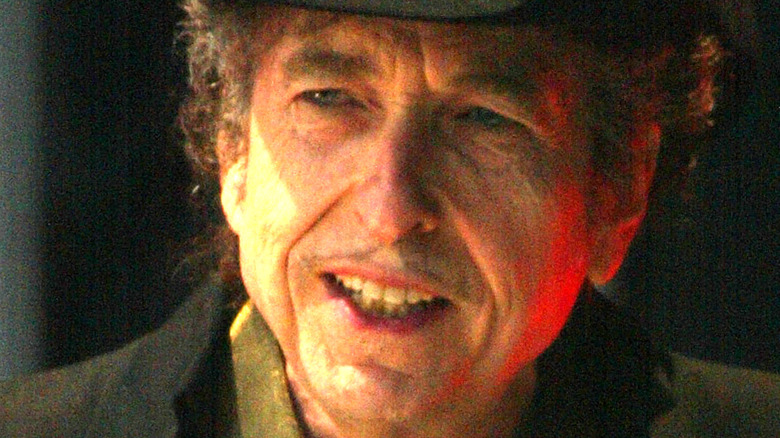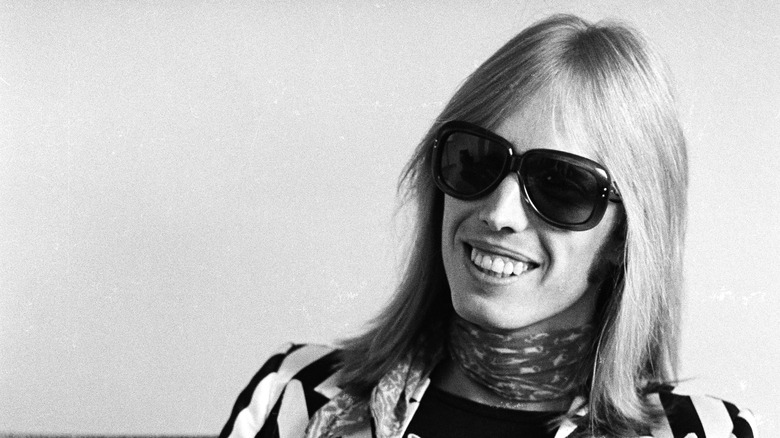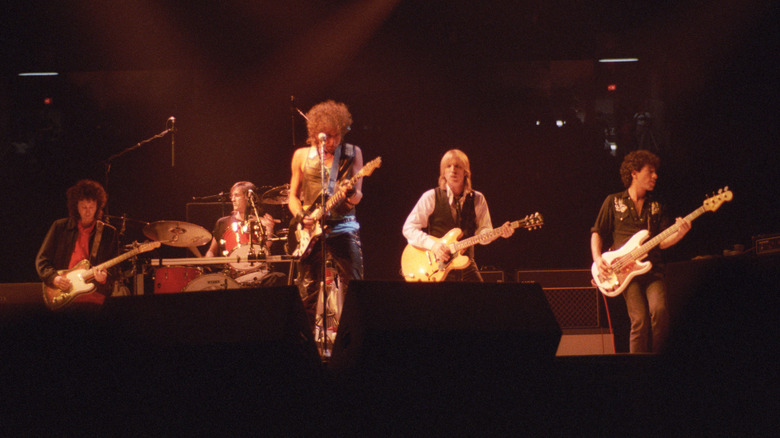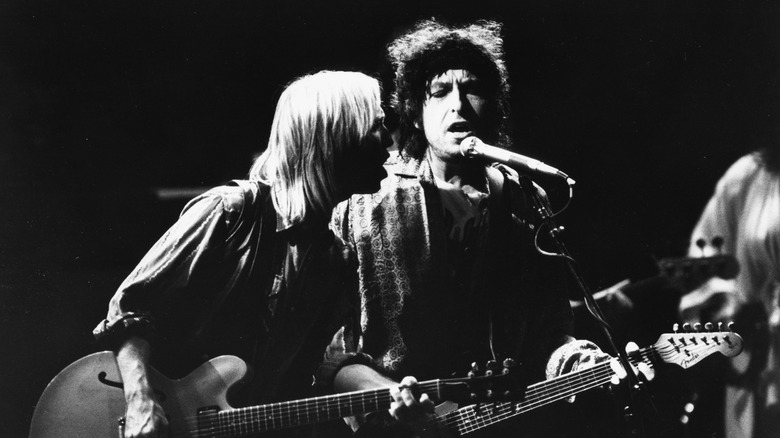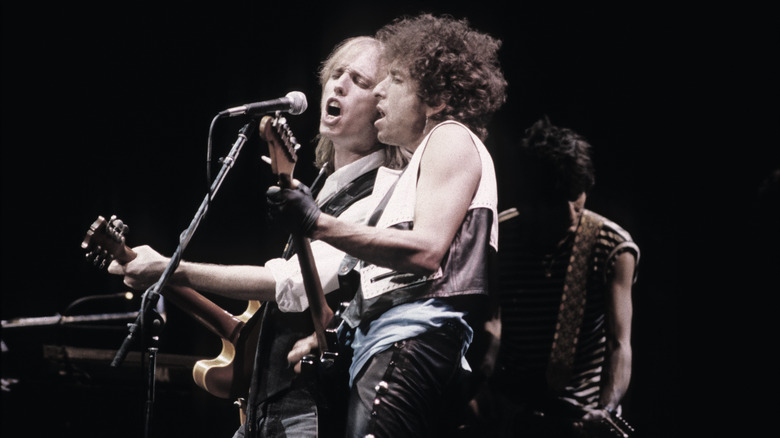The Truth About Bob Dylan's Relationship With Tom Petty
There are few figures in the history of popular music more important in terms of their impact or the respect they elicit than Bob Dylan or Tom Petty. The former's expansive body of work has amassed critical acclaim for more than half a century, and his lyricism was honored with a Nobel Prize for Literature, while the latter's massive contribution to rock music was recognized in 2002 with his induction into the Rock & Roll Hall of Fame alongside his band, The Heartbreakers.
And nor are there many bigger names. To date, Dylan has sold in excess of 125 million albums (via Sony Music), an extraordinary achievement for an artist famous for his disdain for people-pleasing. Even his 2020 album, "Rough and Rowdy Ways," his first original material in over a decade, topped the album charts in the U.K. and placed him on top of Billboard's Artist 100 chart. And with a shorter career to his name, Petty's lifetime sales of more than 80 million are no less impressive (per ABC10). After achieving his first platinum with his band The Heartbreakers in 1979 with "Damn the Torpedoes," he went from strength to strength throughout the 1980s to become one of the few artists in musical history to have an album — his 1993 "Greatest Hits" collection — certified as Diamond for sales in excess of 10 million copies.
But the two stars aren't simply connected by adulation and success. In fact, the two have been hugely important figures in each other's lives, and it might be said that if it weren't for each other, these two songwriters would never have achieved the heights they have in recent decades. Here's why.
Petty was a huge Dylan fan
The music of Bob Dylan had been an enormous influence on the young Tom Petty as both a music fan and a budding musician looking to make his first steps into the music industry as a performer and songwriter.
Petty told American Songwriter that he had been a Dylan fan since the release of "Like A Rolling Stone" and bought all the singles he could. Petty's said his first Dylan album was 1966's "Blonde on Blonde," and he had listened to "Highway 61 Revisited" in 1965 as his friend owned a copy. He explained Dylan's enormous impact on his work and on music in general, telling American Songwriter: "[Dylan] influenced my songwriting, of course. He influenced everybody's songwriting. There's no way around it. No one had ever really left the love song before, lyrically. So in that respect, I think he influenced everybody, because you suddenly realized you could write about other things."
When Petty was in the early stages of his career, he went to see his hero in concert ... and was shocked when Dylan himself introduced Petty from the stage, per "Petty: The Biography." By the mid-1980s, Tom Petty and the Heartbreakers were in the ascendency, building on their late 1970s successes and ready to explore new sonic palettes and ideas. To put it simply, it seemed as though they were capable of anything. They were a major commercial draw, especially on tour, when they would regularly pack out stadiums around the country with screaming fans. Which makes their decision to become the backing band for Bob Dylan in 1986 all the more unexpected.
Petty helped Dylan rediscover his spark
Tom Petty and the Heartbreakers had grown closer to Bob Dylan after meeting him again at Live Aid — at which Dylan and his band gave a notably lackluster performance, according to Petty's biographer Warren Zanes. Dylan and the Heartbreakers met again at the ensuing Farm Aid concert, where Elliot Roberts, the manager both Dylan and Petty shared, asked the latter and his band whether they would be willing to become the older singer's backing group. All devout Dylan fans, the Heartbreakers readily accepted, and the improvement in Dylan's performance was such that a full American tour was planned.
The 1980s had been tough for Dylan. As he explains in his autobiography, "Chronicles," he had lost his creative spark and looked at himself as a "folk-rock relic" of the '60s who was in a "bottomless pit of cultural oblivion." Dylan believed the 18-month-long tour with The Heartbreakers was his last: a final payday before early retirement. One night, however, he wasn't able to go through the motions. Standing beside Petty, he froze, unable to continue ... until out of nowhere, his spark returned, and he felt inspiration and the energy that had propelled him in the early years of his career once more. "Immediately, I was flying high," Dylan wrote. "It was like I'd become a new performer, an unknown one in the true sense of the word ... instead of being stranded somewhere at the end of the story, I was actually in the prelude to the beginning of another one." And if Petty hadn't been propelling him, his renaissance that day may never have occurred.
The truth of the Traveling Wilburys
When you hear the word "supergroup," it immediately conjures the image of stadium-filling tours, monster sales, and even bigger egos. But the Traveling Wilburys — the unexpectedly successful coming together of some of yesteryear's biggest names with Tom Petty, who was just about to hit his commercial peak — was perhaps as humble a gathering of rock gods as you are likely to get.
The band — which was made up of ex-Beatle George Harrison, rock 'n' roll legend Roy Orbison, and Electric Light Orchestra multi-instrumentalist Jeff Lynne, alongside Bob Dylan and Tom Petty — came about entirely by accident, and at a perfect moment for all those involved, as Warren Zanes describes in "Petty: The Biography." Petty had grown to become good friends with Harrison, and he had connected with Lynne to produce his debut solo album, "Full Moon Fever." When the album was shockingly rejected by Petty's label, MCA Records, the musician found himself facing a creative roadblock. But Harrison came to the rescue. Per No Depression, Harrison had to record a B-side for the single "This Is Love." At short notice, he recruited his fell rock legends to contribute, and the resulting song, "Handle with Care," was of such quality that the group decided they were onto something. Rather than keep it a B-side, it became the first single of the five-man supergroup. It was a huge success, revitalizing the careers of many of those involved and providing a welcome distraction from the solo careers of both Petty and Dylan.
The Petty Biography and the disappearing quote
There is a strange incongruity between the two most authoritative histories of Bob Dylan and Tom Petty. The former's autobiography, "Chronicles," is an almost encyclopedic reminiscence of Dylan's creative life, his glories, and failures, faithfully including all the musicians and collaborators he met along the way. However, it is notable that even in the chapter regarding Dylan's miraculous regaining of his creative powers — as quoted above — Dylan never discusses Petty as a performer or his feelings towards him. A reader of "Chronicles" would come away none the wiser whether Dylan was a fan of Petty's or not.
However, Petty wasn't exactly an open book when it came to attitude toward his iconic friend and collaborator. As Warren Zanes explained to Rolling Stone at the time of the publication of his Petty biography, the Heartbreakers songwriter had given Zanes complete access to his life, had met with him often for interviews, and had allowed Zanes to publish whatever details of his life he thought might be interesting. But Petty did draw the line at one tidbit Zanes had included about Dylan: a statement that Petty had made about the elder musician in the 1980s. Petty asked Zanes to remove the quote out of "respect" for Dylan, though the biographer failed to reveal what it was, only revealing that it was not "negative in tone."
The 'shocking' death of Tom Petty
Tom Petty died suddenly of what was believed to be an accidental drug overdose on October 2, 2017. As his widow Dana told Billboard on the anniversary of his death in 2018, the timing of his death was tragic. At 66 years old, he just had completed an arduous tour comprising 53 dates over four months. Believing that the tour might be his last, Petty had held off on surgery for an excruciatingly painful broken hip, choosing instead to tour. "[H]e was stubborn," Dana admitted. "He'd had it in mind it was his last tour and he owed it to his long-time crew, from decades some of them, and his fans."
Petty's sad death affected Dylan deeply, with the famously tight-lipped musician releasing a public statement revealing his grief at the loss of his long-time friend and collaborator. He told Rolling Stone: "It's shocking, crushing news. I thought the world of Tom. He was a great performer, full of the light, a friend, and I'll never forget him." Weeks later, Dylan paid a musical tribute to Petty at a concert in Colorado, playing an unexpected version of Petty's hit song, "Learning to Fly."
